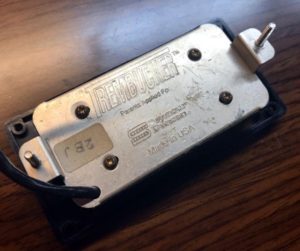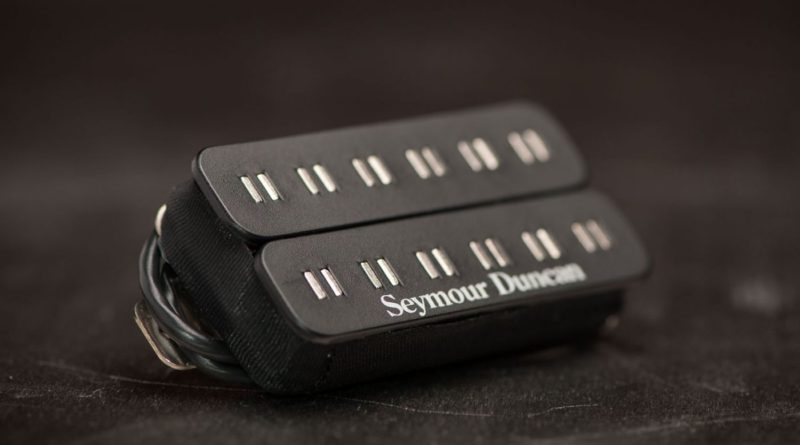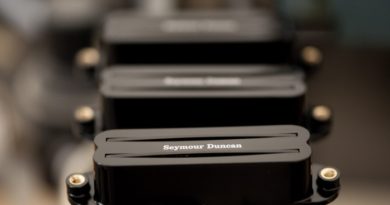Seymour Duncan Parallel Axis Distortion

The Parallel Axis Distortion PATB-2 is a bridge humbucker that I hear about from people here and there. Seeing that I do like the Parallel Axis Original PATB-1 bridge and the Crazy 8 bridge, I figure this one is worth a go.
As near as I can tell, the Parallel Axis Distortion also hit the shelves around 1993. Same as the rest of the production PATB series. You can hit up my article on the PATB-1 set for a little bit on the way the dual-pole design works and an approach to finding the sweet spot.
Wouldn’t ya know, I managed to procure an older PATB-2 with MJ’s 2BJ sticker on it (like the label on the one in the photo of the baseplate). For a bit of consistency, I have the Parallel Axis Distortion paired with the PATB-1 neck model in the same guitar as the review for the PATB-1 set. As with the PATB-1, the Parallel Axis Distortion has 4-conductor lead wire. I wire each pickup to have it’s own switch for series/split/parallel options.

With a thick ceramic magnet and Distortion right there in the name, one might think the Parallel Axis Distortion is the same as the Duncan Distortion. Well, ease up there, pilgrim. It does have more mids than the PATB-1, but less upper mids. And not quite the searing sharp bite of the Duncan Distortion. The lower resonant peak contributes to a smidge more girth as well.
Starting out with a dirty amp tone, you know the Parallel Axis Distortion is right at home. It has a slightly constricted, compressed low-mid grunt that sets it apart from the Duncan catalog contemporaries. The lows are percussive and in the pocket, which is to say that you’ll be mud-free. The highs are something that will be interesting for players that want a bridge pickup that can scorch without a piercing ice pick character.
Looking at a name like Parallel Axis Distortion, you could be wondering about the clean tones. In series mode, you might be tweaking your amp a little. Switching to a split wiring really cleans up more than I would have expected. In the middle position with both pickups split, you have a pretty darned versatile glassy clean option.
Take a listen to this video of Ola Englund throwing down with a Parallel Axis Distortion bridge and 59 Model neck:
Want some specs:
Inductance – 11.45 H
North – 10.021 K
South – 9.993 K
Parallel – 5.011 k
Mids – 6
Treble – 7
Resonant Peak – 3.9 KHz (advertised)
Magnet – Thick Ceramic
The Parallel Axis Distortion is going to be right at home with hard rock and metal. I’m gonna say you’ll be alright throwing down with some drop tunings on this bad boy. Consider the Parallel Axis Distortion to be the fire-breath dragon, compared to the laser-beam viciously precise options for djent and other modern metal styles.
For reference, this Parallel Axis Distortion bridge pickup evaluation was conducted with a Fractal Axe-Fx II XL+ featuring Celestion Impluse Responses and Fractal MFC-101 MIDI Foot Controller. Real cabs used were Marshall 1960B cabs loaded with Celestion G12-65s, Vintage 30s and G12M Greenbacks.
Seymour Duncan Website | Facebook | Twitter | YouTube | Instagram




